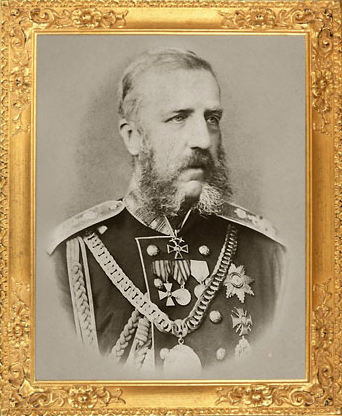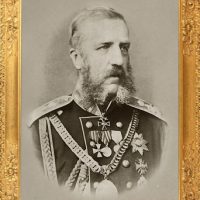Semyon Mikhailovich Worontsov
Worontsov Semyon Mikhailovich (10/23/1823 – 05/6/1882) was the son of Field Marshal M.S. Vorontsov from his marriage to Countess Elizabeth Ksaveryevna Branitskaya, His Serene Highness the Prince.
In 1842, S.M. Worontsov graduated from the Richelieu Lyceum in Odessa (the Lyceum was established on May 2, 1817, in 1865 it was transformed into the Novorossiysk University) and for some time was listed in the Department of Foreign Affairs.
On October 2, 1847, the titular adviser, Prince Semyon Mikhailovich, who held the court rank of chamberlain, was assigned to serve in the Preobrazhensky Regiment of the Life Guards and appointed an aide-de-camp to His Imperial Majesty. Usually, the award to the Retinue “took place for the preservation of combat units in proper order, for outstanding distinctions and selfless performance of their duties.” However, there were other reasons for awarding a military rank. The latter was sometimes given for the merits of the ancestors. In the rescript Nicholas I addressed to Prince M.S. Worontsov on this occasion it was stated:
“… remembering that your initial field of service was a civilian part and that you, following your own inclination, joined the military service in the region where your son, Prince Semyon, was constantly with you, sharing all the labors and dangers of the war, I could not deny myself the pleasure of directing his service to the path you are following. In these forms, I have appointed your son to my wing as an adjutant with enrollment in L.-G. The Preobrazhensky Regiment is a staff captain and with a fortune with you, fully hoping that he, too, following in the footsteps of his valiant father, will be a worthy and excellent warrior like him.” (Shcherbinin. Biography of Field Marshal General M.S. Worontsov).
As the commander of the Kurinsky Infantry regiment in the Caucasus, Semyon Mikhailovich participated in many military operations, in 1851, he came out of the mountains and was handed over to the Russians by Hadji Murad.
On August 26, 1851, S.M. Worontsov married the widow of Colonel A.G. Stolypin, Maria Vasilyevna Stolypina. The wedding took place in the Alupka Palace.

October 1, 1852 “Worontsov, Prince, Semyon Mikhailovich, commander of the Jaeger adjutant General of Prince Worontsov’s regiment, wing adjutant E.I.V. Colonel of the kn. Worontsov, for distinction in cases against the Highlanders, was promoted to Major General with an appointment to the retinue of E.I.V.”
In 1853, Semyon Mikhailovich surrendered command of the regiment and went abroad. Upon his return to St. Petersburg, he commanded the first battalion of the Preobrazhensky Regiment for some time, in the archive of which he found secret papers on the case of Tsarevich Alexei Petrovich.
The reviews of contemporaries about Semyon Mikhailovich were contradictory, some gave the prince derogatory characteristics, calling him “a man in no way interesting, sluggish, loose”, “he did not resemble his parent in any way, either externally or spiritually”, others noted the prince’s practical mind and admired his courage.
1855 September. From the letters of Alexandra Osipovna Smirnova. (Russian Archive. 1897, book 3) “These eleven months of the siege of Sevastopol are a real nightmare. Worontsov (Prince Semyon Mikhailovich) was more seriously wounded than I was told: he received a concussion from a bomb fragment” (p. 125), “… He (A.I. Baryatinsky) respects Semyon Worontsov and is very glad that he finally received the brigade he asked for at the beginning of the war. He saw him in action in the Caucasus, where he sacrificed his life. He told me: “Krasnoselsky generals are enough for parades; Semyon Mikhailovich is not suitable for Krasnoselsky generals; He is a military and combat general. I’m not telling you that he was a commander; but there are so few of them.”
On December 6, 1856, “The Retinue of E.I.V., Major General Prince Worontsov was appointed adjutant General to E.I.V. (From the book “The Retinue of E.I.V.”).
After the death of St. Prince M.S. Worontsov in 1856, Semyon inherited a huge entail founded by his father and proved himself to be a truly diligent owner, especially in the field of viticulture and winemaking. The wines of his south coast estates were a well-deserved success and surpassed the overseas ones in quality.

On December 23, 1863, upon the introduction of a new public administration in Odessa (approved on April 30, 1863), His Serene Highness Prince Semyon Mikhailovich Worontsov was elected mayor by a majority of votes (122 against 12). When he received a notification about this by telegraph from Count Tolstoy, on December 25, he replied with a telegram addressed to the latter: “Deeply touched by the trust of the citizens of Odessa, I accept such a flattering appointment for me and will use all my efforts and efforts to be worthy of their choice.” The first mayor of the post-Reform Duma, St. kn. Sm. Worontsov worked hard for Odessa, but after completing his term of service, he refused further service. A photograph of the prince is kept in the palace museum, where he is depicted with a massive chain of the mayor, worn over his uniform.
In 1864, Semyon Mikhailovich informed the manager of the Crimean estates that he would live permanently in Crimea and gave instructions on the proper conduct of business. Since that time, the Worontsovs spent most of the year in Alupka, arranging constant receptions and celebrations in the palace. Semyon Mikhailovich, being a Member of the first City Duma in 1871, actively participated in the public life of Yalta.
In 1874, Adjutant General S.M. Worontsov was ordered by Emperor Alexander II to study the problem and make proposals on what nonviolent ways to keep the Tatar population of Crimea. Having visited the Simferopol, Feodosiya and Yevpatoria counties of the Taurida province for this purpose, the prince came to the conclusion that the real reason for the departure of the Tatars from the Crimea was the new law on military service. Worontsov, referring to his knowledge of the habits and character of the Tatar population, suggests taking into account the importance of the ways in which “in the present case, a new conscription will be introduced among the Tatars. The more humane and applied to their mores and customs these methods are,” he adds, “the more firmly and sooner the love of military service will be instilled in the Tatars.” Among the necessary measures, S.M. Worontsov included consideration of complaints from Tatars about the appropriation of lands and houses belonging to them by the treasury, the completion of the process of disputed cases of forest dachas alienated from the South coast Tatars in 1838. He raised the issue of allocating field plots on state-owned lands to steppe Tatars for a reasonable price with installments for a long time and the possibility of allowing the issuance of passports to the Tatar population for pilgrimage to Mecca; insisted on the need to continue laying highways between mountain settlements near Sudak and Alushta, Feodosia and Karasubazar. (Russian Archive, 1906. No. 7).
Prince Semyon Mikhailovich often referred to his father’s experience in his actions and unwittingly copied it in everyday life. Here are excerpts “From the Notebook of the Russian Archive.” They belong to the pen of Pyotr Ivanovich Bartenev (1829-1912), a Russian archaeographer and bibliographer, who for many years published with Semyon Mikhailovich the “Archive of Prince Worontsov” (books 1-40, 1870-95).
“Prince M. S. Worontsov told his son: “People with power and wealth should live in such a way that others forgive them this power and wealth.” Once in Alupka, Prince S.M. Worontsov asked me if I noticed any haste of the servants in his house and the workers in the garden. “Not at all,” I replied. — I have up to 60 people, and everyone knows exactly what to do. In this I imitate my late father. Once, on a hike in the mountains, he dismissed from service an orderly who had been with him for several years in a row. They were perplexed about what, and when they asked the prince about it, he replied: “I sent him with an order, and he galloped headlong to execute it, which confused those around me; the nearest ones thought whether my order had any special significance. The orderly insulted me; for what kind of commander-in-chief am I, since I do not know how to manage time.” (Russian Archive 1910,12, p. 681).
In the 1870s, S.M. Worontsov remained one of the richest landowners in the Crimea, only on the southern coast he owned 2,404 des. 1019 fathoms. land. Of these: in Alupka — 267 des. 549 fathoms. land; Cocose — 5 days. 801 fathoms; Novo —Petrovsky- 1002 d. 1698 s.; Barbo-Cristo — 46 des.; Massandra -656 des. 2117 fathoms.; Ai-Danile — 381 des. 714 fathoms.; Jakson site in Ai-Danile -28 des. 898 fathoms.; Alushte (Ala-Chukh) — 16 des. 1390 fathoms.
He died on May 6, 1882 in St. Petersburg at the age of 59. With the death of S.M. Worontsov, the Worontsov direct male line was suppressed.

In the Caucasus, he commanded the Kurinsky Jaeger regiment. L.N. Tolstoy in the story "Hadji Murad" gave a verbal description of S.M. Worontsov: "A long-faced blond colonel with wing-adjutant monograms and aiguillettes"
“Hadji Murad” by L.N. Tolstoy
«He, following in the footsteps of his valiant father, will be a worthy and excellent warrior like him».
Emperor Alexander II on the appointment of Semyon Mikhailovich Worontsov in the Life Guards of the Preobrazhensky Regiment as a staff captain
